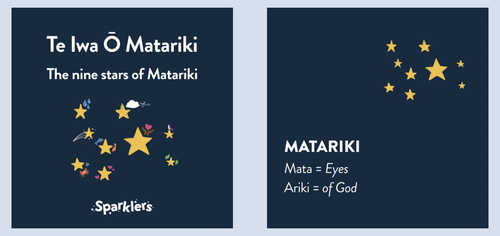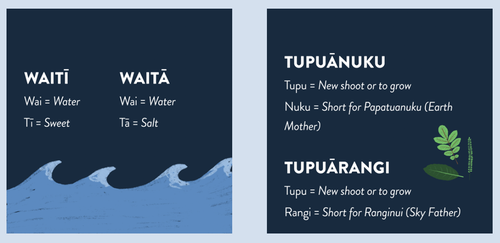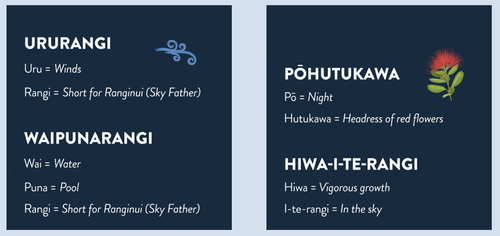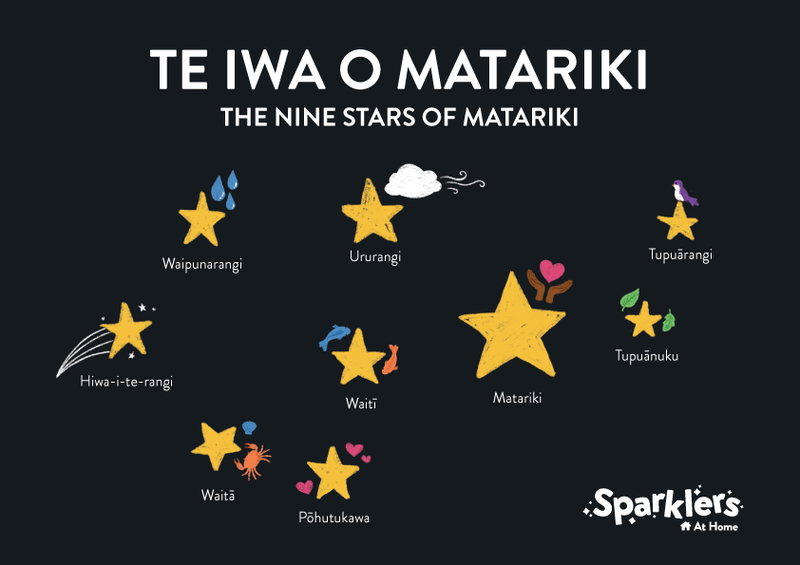Throughout the whole Pacific the Matariki cluster of whetū (stars) is most commonly known as Matariki, which means the eyes of the chief or eyes of the God.
In Aotearoa, Matariki is shortened from Ngā mata o te ariki Tāwhirimātea (the eyes of the God Tāwhirimātea).
Tāwhirimātea is the God of weather who was deeply saddened and enraged with the separation of his parents Ranginui and Papatūānuku. Tāwhirimātea fought with his siblings, but was beaten by Tūmatauenga (the God of humanity, commonly known as the God of war). Tūmatauenga defeated Tāwhirimātea, and out of love for his father and spite for his brothers, Tāwhirimātea pulled out his eyes, crushed them and threw them upwards where they stuck to the chest of his father Ranginui – ngā mata o te ariki Tāwhirimātea (Matariki) – the eyes of the God Tāwhirimāmātea.
This also accounts for the weather being so wild and unpredictable. Tāwhirimātea is blind and angry.
Here's a video link to Prof Rangi Matamua explaining Matariki
You might like tamariki to research images of Tāwhirimātea, Tūmatauenga or Ranginui, or tamariki could draw or paint these Atua. We love the illustrations of Ngā Pūrākau (creation narratives) from Kuwi & Friends Māori Picture Dictionary by Kat Quin and Pānia Papa and have also seen posters of their illustrations too. The Christchurch City Libraries had an awesome collaboration with Maui studios depicting the whetū too!
There are so many great illustrated books about the Atua and Matariki (just be sure to look for the nine whetū).
When is Matariki?
Matariki changes every year because traditionally Māori follow the maramataka (lunar (moon) calendar) where the environment dictates timing. Whereas Western traditions follow a solar calendar which allows for times of year to remain the same e.g. New Years day. Here's Prof Rangi Matamua video to tell us more.
The best time to look for and celebrate Matariki is during the marama phase of Tangaroa. It marks the most prosperous time. These are the timings based on Dr Rangi Matamua's research
This year (2022), the first public holiday to celebrate Matariki will be on Friday 24 June, marking the reappearance of the constellation. The best time to view the Matariki cluster is early morning, just before dawn.
How to find Matariki
We thought this video was a pretty clear guide.
The whetū (stars) of Matariki
Some iwi believe there are 9 whetū (stars) that make up the Matariki cluster, and some 7 whetū. If this is your understanding and belief, please remove Pōhutukawa and Hiwaiterangi.
These Matariki whetū illustrations are available to download. They may be useful for digital display or Seesaw activities. Some kōrero notes have been added below too.



- Pōhutukawa – is the oldest star and connects with those who have died each year – she guides the matū (spirits) of our loved ones across the sky night after night.
- Tupuānuku – is connected to all the things that grow in our garden and will determine how well out garden will grow in the upcoming season.
- Tupuārangi – is connected to anything that grows in the sky, particularly anything we may harvest like birds, and berries.
- Waitī – is connected to anything that comes from the rivers or lakes (fresh water).
- Waitā – is connected to all the animals that come from the moana (sea).
- Waipunarangi – is connected to rain.
- Ururangi – is connected to the wind.
- Hiwa-i-te-rangi – is a star where we send our wishes for the year hoping they will come true.
- Matariki – is a healer and married to Rehua (a medicine man). When her star is shining bright and you’re sick, or someone you know is sick, this is a sign you or they will get better. It’s important to understand that the 8 children of Matariki and Rehua each have a bounty for humankind. Matariki is their guardian.

You are really welcome to download this image and print as an A4 or A3 size, or use this colouring-in version. It would also be cool to project it up, and have tamariki recreate it - use ink and crayons, biodegradable glitter, black cardboard, star cut-outs and cellophane for window displays... we know how creative you are!
We also have these powerpoint slides to support your kōrero about each whetū with your tamariki
Reading the whetū
The stars of Matariki foretell the year ahead, based on each whetū brightness – the combination of these determines your year winter to winter, especially in terms of kai (nourishment). Matariki signals mātahi o te tau (the new year).
How did our ancestors welcome Matariki and te mātahi o te tau (the new year)?
The importance of Matariki on the following year required an offering te umu kohukohu whētu – a sacred kai ceremony from the stars (as they bring the previous year’s bounty) to feed the weary, hard-working chiefs of the sky.
It is also a time to ‘release’ our loved ones who have passed away during the year. Their names are called out in order that Pōhutukawa can carry their mātu (spirit) as part of Te Waka o Rangi, another cluster of whetū (forming a waka) which gathers mātu over a year, and eventually casting these out as whetū (stars).




